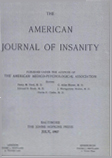Abstract
1. The average uncorrected size of family was found to be 5.6 children. When subjected to the correction for the sampling error, however, the size of family is reduced to 3.9. The well-known tendency of foreign born mothers to have a large number of children, and the excess of those mothers in our sample tends to over-load it with the larger families. Correcting for this excess results in an average of 3.5 children for families involving mental deficiency. This average is practically the same as that of the general population (Fig. 1).
2. The relationship between size of family and the intelligence quotient of the children examined is outlined in Fig. 2. Small families show children who have higher intelligence quotients, and the low average intelligence quotients are observed in children from the larger families.
3. Tables A and B with Fig. 3 outline the relationship between size of family and the number of siblings, other than the patient, who are retarded or mentally defective. Excluding the patient in each family, we have an average of .125 retarded and .075 mentally defective, per other sibling born. Little variation in these proportions is seen in families of different-size. There is no tendency for larger families to produce relatively larger proportions of retardates or mental defectives.
4. Table C and Fig. 4 outline the findings with reference to size of family and average grade accomplishment in language, arithmetic and reading. In language, the children from the smaller and the larger families show the highest accomplishment, with the intermediate families showing a low average accomplishment. In reading, the children from small families showed the highest accomplishment, the poorest average accomplishment being shown in the larger families. In arithmetic, the children from the small families make the poorer average showing, while the children from large families show the higher degrees of accomplishment.
5. Fig. 5 outlines the relationship between size of family and the average number of physical defects. Children from small families have the fewest physical defects, and there is a steady upward trend with the highest average number of physical defects occurring in children from the larger families.
6. Fig. 6 and Table D present the findings in relation to size of family and the environmental status of the homes of these children. Environment rated as "good" is found more frequently in families of smaller size. Conversely, environment rated as "poor" shows high percentages in the families of greater size.
7. Fig. 7 and Table E point out that there is an apparent association between the occurrence of truancy and the larger families.
8. The influence of size of family upon the occurrence of certain conduct problems in our children is outlined in Fig. 8 and Table F. "Normal conduct" is more frequently found in the smaller families. "Stealing" shows a slight tendency to predominate in the smaller families. "Lying" demonstrates larger proportions in the larger families. "Sex offenses" present the largest percentage in the small families.
9. The relationship between size of family and the occurrence of certain personality traits is presented in Figs. 9 and 10, and Table G. Certain of these personality characteristics tend to show a definite association with the families of larger size. These are as follows: "obedient," "social," "stubborn," "suggestible" and "quarrelsome." Other personality traits tend to associate themselves with the smaller families. These are: "emotionally unstable," "seclusive," "selfish," "egotistical" and "over-affectionate."
10. The factors discussed in this paper show certain tendencies toward association with either the small or the large families. The following factors associate themselves with the smaller families:
See table in the PDF file
11. The following factors associate themselves with the larger families:
See table in the PDF file
12. Apparently mentally deficient children from the small families retain a greater degree of individuality, with wide ranges in departure from the average or normal either on the plus or negative sides. In other words, their characteristics tend to be very favorable or very unfavorable. Their good characteristics carry promise of successful performance; their unfavorable traits carry rather serious implications of future difficulties. Children from the larger families tend to merge with the mass, adjust socially and present a narrower range of variation above and below the average. Their favorable characteristics are more social in nature and more conducive to adjustment than performance. With the possible exception of physical defectiveness, their unfavorable characteristics are less serious in nature, and are less liable to interfere with future adjustment.
13. The results suggest that an environmental influence, such as size of family, may be associated with certain differences in the characteristics of mentally deficient children. The findings bring up the possibility that other environmental factors may exert a similar influence upon the development of a group hitherto regarded as being rather fixed in characteristics.

